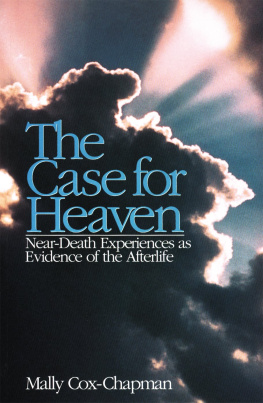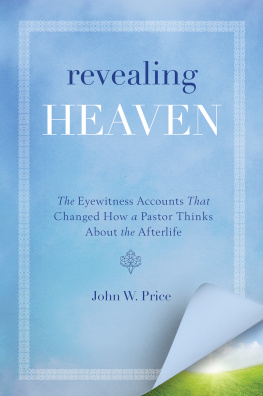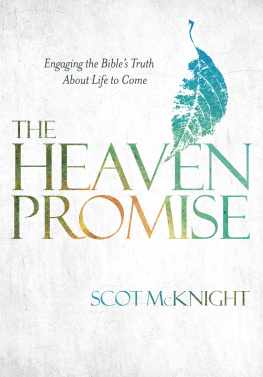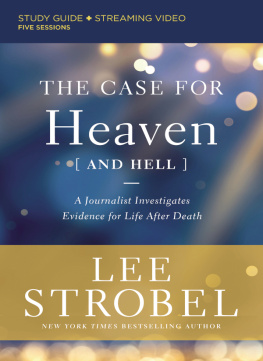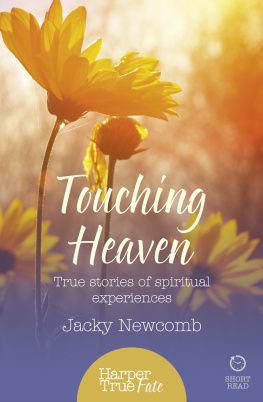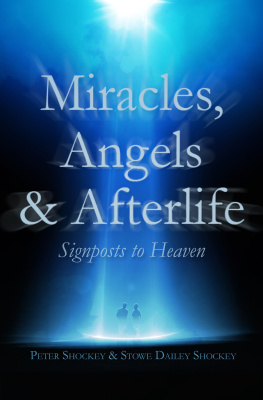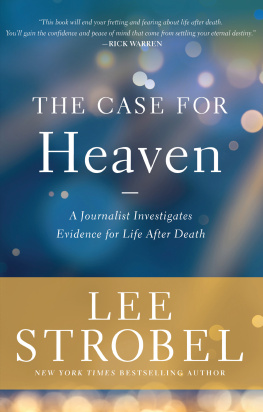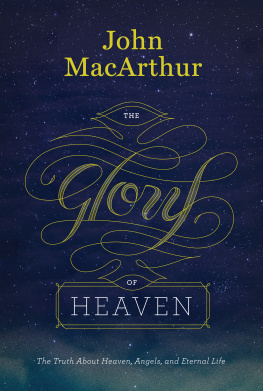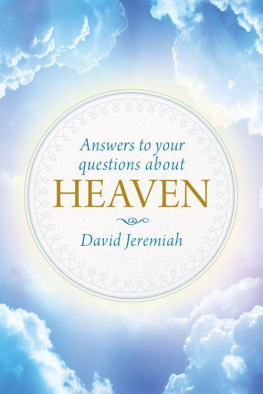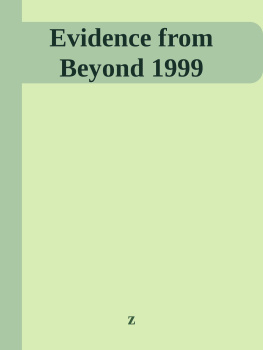Chapter 1
What Can Near-Death Experiences Reveal about Heaven?
and we have no evidence whatsoever that the soul perishes with the body.
MAHATMA GANDHI
H eaven is real.
Wouldnt it be wonderful to know that? Can you imagine how you would feel with certain knowledge of life beyond death?
A group of parishioners at a small country church were listening to a talk on Heaven when a short, heavyset policewoman named Dorothy Young raised her hand. She told the congregation that she knew there was a Heaven because she had been there. She had been in the hospital in the process of miscarrying her fourth child when she felt a cold, dark chill pass over her. Suddenly she was surrounded by a warm, bright light that totally enveloped her. She felt happier than she ever had before. It was utterly quiet, she said, a quiet without shadows or walls. She heard the sound of a baby crying deep in the Light. She was given to understand that her stillborn daughter was going to stay in the Light and that she was fine.
When Dorothy came back from the gray mist where she had heard her baby, a sheet was over her head. She had been pronounced dead. When she pulled the sheet off her head, the nurse in the room shrieked and had to be sent home. Dorothy herself has never grieved for the baby who was born dead. She has a bone-deep conviction that because she was a mother to three other children, God pulled her back to finish her work on earth. She believes she will see her stillborn daughter in Heaven.
As Dorothy finished her account, the church group sat in stunned silence. This was not some stranger talking. This was Dorothy, the calm dispatcher at the police station, the one everyone called when there was a crisis in town. This was their neighbor.
Each person listening to Dorothy had to decide if her story was trustworthy. Each had to wonder what it meant. As Dorothys own pastor said afterward, Ive never really paid much attention to near-death experiences. I thought of them as fodder for made-for-TV movies. But my godmother changed her life because of one, and now Dorothys telling hers, and Im thinking, This is really important.
An impressive number of Americans and people all over the world have had near-death experiences, or NDEs as they are commonly called. According to a Gallup poll, at least eight million people in America alone have had near-death experiences. Nearly all near-death experiencers have an unshakable belief in the afterlife.
The argument presented here is not religious in the traditional sense. There will be no discussion of Ten Commandments or Four Noble Truths, no guides to the Way to Live. But near-death experiencers function as a wellspring of collective religious revelation about Heaven. Experiencers are telling the people around them what they have learned. The power of their conviction is having an effect.
About half of the experiencers interviewed offered to tell their story after reading about this study in the newsletter for the International Association of Near-Death Studies (IANDS). The others heard about it through word-of-mouth. Most were interviewed twice.
Many more women than men volunteered for this project. As Dr. Kenneth Ring, a professor of psychology at the University of Connecticut and the dean of near-death research, has pointed out, although women are more willing to discuss their near-death experiences, his research indicates that there is no discernible difference between men and women in terms of the experiences themselves.
Only two of the experiencers asked to have their names changed, and both of those were for good reasons. One is a health-care professional who felt that her career would be jeopardized; the other had her near-death experience in connection with a rape and murder. Her assailant may still be at large.
Even when the stakes were not as high, many experiencers interviewed for this book admitted it felt risky to share their stories. Dorothy Young had told no one except her mother and best friend for fear of being judged as odd. But as public acceptance of near-death experiences grows, many of those eight million are telling family and friends what they have learned.
If a friend confided in you over tea late at night that she had had a near-death experience in which she went to Heaven, you would probably listen with respect, and maybe with wonder or skepticism, depending on your temperament. The story might or might not persuade you that there is another side. But what if ten people told you similar stories over tea late at night? What if fifty friends confided such accounts? Eight million? At what point would their conviction become your religious question? At what point would you have to reconsider your own faith journey?
Sheer numbers would not usually be sufficiently persuasive. Many more than eight million people throughout history have believed in human sacrifice, yet few are inclined to accept such religious practices today. But Aztecs and Incas chose their beliefs. Experiencers have change foisted upon them. Dorothy, for example, grew up in a Christian family. One might assume that a revelation of Heaven would confirm joyfully her familys most dearly held beliefs. Instead, Dorothy has felt that her experience of Heaven put a difficult burden on her. She has lived with the uneasy feeling these past twenty-seven years that she ought to do something with her experience. She was supposed to be a messenger, but she did not know to whom. Dorothy hopes that by telling the group at church and through participation in this study that she will somehow have fulfilled her obligation.
Bettina Pratt, a tiny Bostonian lady in her sixties, has also told very few people about her experience. She contracted encephalomyelitis, a complication of measles, when she was nineteen. She remembers perceiving herself as hovering just below the ceiling of the infirmary room looking down on a doctor, a nurse, and the shape of her own body under the sheets. The nurse said, I cant get a pulse in a panicky voice.
Suddenly Bettina was on the edge of something she feels she cannot adequately describe. She says, How can one describe a light that is very, very bright and very, very soft at the same time? I knew that it was living and loving and that I was going to get into it, and I could hardly wait. There wasnt any me anymore. I didnt have a body, and yet I didnt hurt. I should have hurt, but it was so bright I was awed and overjoyed, and I knew where I was and why. I call it heavenly, because thats the best word weve got. It was bliss.
This experience had a profound effect on Bettinas life. Her fear of death, which had caused nightmares all her life, was gone forever. She has spent much of her life learning about spirituality and Eastern mysticism as a way to understand what happened to her as a teenager.
Bettinas experience, like Dorothys, creates a methodological problem: her NDE is self-reported and cannot be verified objectively. Death or its relative nearness is sometimes hard to define. Visits to the edge of Heaven cannot be proved. Some researchers have found that an experience can occur even when the closeness of death is not clear. Experiencers themselves almost always speak of themselves as being dead, and they have reasonable corroborative evidence to back up their claim. Only those interviewees whose proximity to death was persuasive have been included. In fact, medical understanding is making it increasingly clear that there is no such thing as a moment of death. If dying is a process, the soul may intersect with another plane of reality anywhere along a continuum. Like explorers standing on a hillside with binoculars, near-death experiencers glimpse our common destiny.

